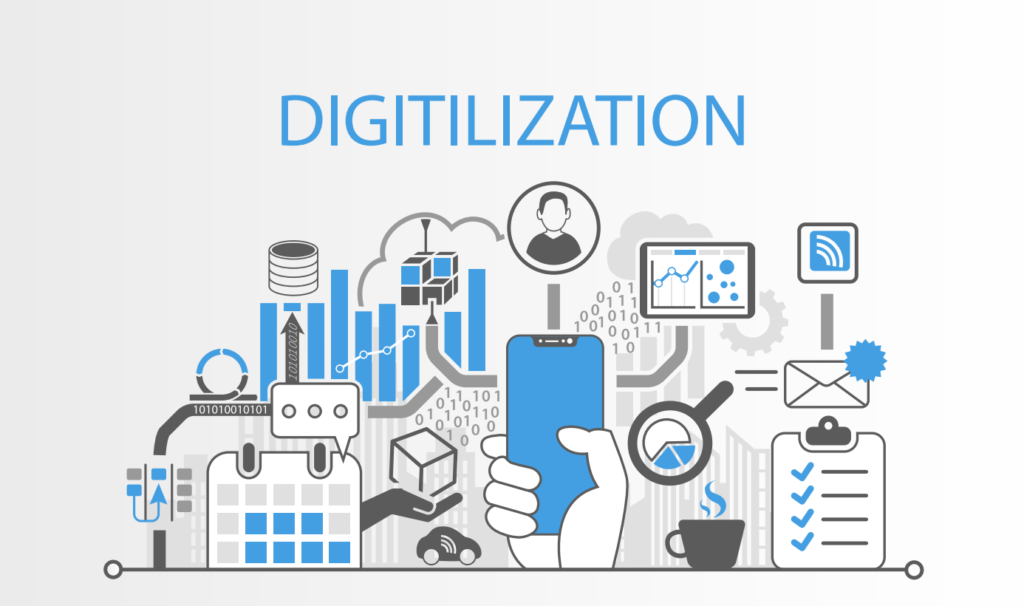The importance of digitalisation
What is digitalisation?
Digitalisation, or digital transformation, describes the process of an organisation adopting digital technologies across every part of its business. That includes sales and marketing e.g. advertising on social media and using customer relationship management platforms, administration and planning e.g. electronic invoicing or cloud accounting, and production and logistics e.g. real-time inventory management and online delivery tracking.
Every business will have different approaches to digital transformation. And while there are countless benefits of using the latest software and platforms, as well as motives given by the government – the SME digitalisation grant, the culture change and commitment required to integrate them can be challenging.
That’s even more likely to be true of SMEs, with their smaller budgets, smaller workforces and sometimes limited in-house technological expertise.

How the tech and other industries have led the way in digitalisation
Not surprisingly, tech industries have been digitalisation pioneers. For those whose business is all about digital products and services, working digitally comes naturally. The retail, construction and logistics industries have also been quick to recognise the benefits to their business and their customers, and are reaping the rewards, especially through the introduction of enterprise resource planning (ERP) software to manage functions including manufacturing, stock control, procurement and sales etc.
The restrictions of the Covid-19 pandemic have accelerated that trend across other industries. The need for remote working forced some companies to address their
longstanding reluctance to introduce new systems. Most have discovered that the advantages of taking their business processes into the cloud far outweigh the problems they’d anticipated.
Governments have also encouraged modernisation, targeting SMEs with financial support and advice, training and networking opportunities to help them get the most from
technology. Government initiatives are making some digital transformation essential, such as the UK’s HMRC “Making Tax Digital” programme which requires digital returns from businesses registered for VAT.
Why digitalisation?
Although different business types experience different benefits from digital technologies, there’s agreement on many of them:
- Better information access – from customer profiles to raw material delivery dates
- Quicker communications – between staff, suppliers, customers and partners
- Reduced costs – such as transaction costs, access to high-quality cloud-based software, and manpower savings from using digital services
- Easier international trade – from online border controls and customs procedures, through industry-specific e-commerce solutions, to smoother communications with vendors, manufacturers and end-users
- Improved access to business resources – including training, recruitment, and government support, and accessing expert advice remotely, regardless of their location
- Enhanced business performance – using cloud computing to access business innovation tools to upgrade internal processes, and using big data analysis to understand customer behaviour, sales trends, optimum stock levels and more
- Higher productivity – thanks to more efficient tools, automated processes, better information to identify blocks and delays, and less wasted time
- Increased competitiveness – from cost reductions, better efficiencies and the opportunity to expand services.
The effects of digitalisation are everywhere
It’s not hard to spot how much of everyday life has gone digital recently.
Many more people are familiar with the idea of working from home. Software like Zoom and Slack has made collaborating with colleagues around the world as easy as chatting with a team based just a few desks apart.
Meanwhile, online shopping has become the norm, for everything from groceries to furniture. The latest digital software provides chatbots to respond to customer enquiries
24/7 and tracks deliveries from despatch to the front door.
That broad familiarity with digitalisation can only make it easier for businesses to transform.
The Challenges and Gaps for SMEs
Despite the widely-acknowledged benefits, digitalisation of SMEs is especially challenging. According to Eurostat(1), just 20% of European SMEs were using cloud-based services in 2016, compared to 45% of large businesses. And the SME SURVEY 2019(2)report confirms that while 65% of SMEs have adopted at least three digital technologies, among the remainder there’s a huge reluctance to invest in innovation. The biggest challenges that small and medium businesses face when undergoing digitalisation include:
- Skills and technology
Few SMEs have the expertise to identify what technology will make be most suitable and transformative for their business, let alone implement those changes.
- Financial
It can be tricky to fund the software and hardware needed for digital innovation, especially if banks won’t lend against this type of investment.
- Infrastructure
Digitalisation is impossible without reliable high-speed broadband, and SMEs based away from large cities often have poor internet access.
- Culture
Smaller businesses can struggle with making major changes to working practices, because they’re more susceptible to personnel disruption, or less familiar with any business transformation.
- Security
SMEs may be more likely to be targets of hackers, phishing campaigns, scams and other cybercrimes, and be less well-prepared for attacks. As well as being more vulnerable to security breaches they’re less able to bear the considerable costs.
How China Telecom (Europe) helps SMEs bridge the gaps
China Telecom (Europe)’s digitalisation solutions can help SMEs catch up with larger firms and smooth the digitalisation process for all kinds of organisations.
Choosing to work with CTE as an external partner can speed your business’s digital transformation with:
- Broader expertise and better connections than most internal IT teams
- Faster implementation time and a shorter learning curve
- More flexible approach, using their experience of the wide choice of relevant software,
platforms and tools - Secure, stable and reliable connections, over international private lines (IPL) or
broadband - High-quality ultra-low latency infrastructure for fast, flexible connections
- Cloud solutions to keep your data safe and your business connected
- IDC and Colocation services to eliminate the cost and complexity of running your own
data centre and provide external IT infrastructure.
Contact us today to find out how CTE can help your business transform.















 Return to Blogs & Related News
Return to Blogs & Related News

